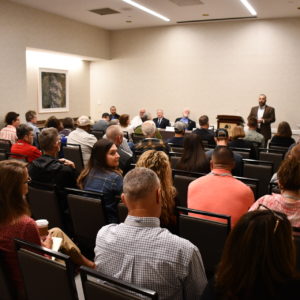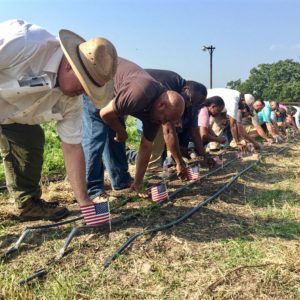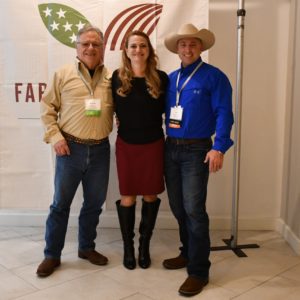Conference focuses on enhancing agricultural opportunities for military veterans
Texas AgrAbility, Battleground to Breaking Ground among programs highlighted

Texas A&M AgriLife Extension Service programs that assist military veterans in returning to agriculture or starting an agricultural enterprise operation were among those showcased during the recent Lone Star and Stripes Farmer Veteran Coalition Stakeholders Conference in Austin.
The conference was touted as the fifth national event held by the coalition “featuring two days of education, workshops, distinguished speakers, guest panels, networking and more.”
Conference speakers and sessions
Texas Land Commissioner George P. Bush, a Navy veteran, was among the speakers at the conference, which was coordinated by the coalition and currently estimates its national membership at about 17,000.
Bush noted his admiration for the Farmer Veterans Coalition and its mission to mobilize veterans to feed Americans. He also said one of the more rewarding aspects of his position as Texas Land Commissioner was his role on the Texas Veterans Land Board, which “gives veterans the opportunity to have their own piece of Texas.”
Erin Kimbrough, AgriLife Extension program manager for the Battleground to Breaking Ground program, was among the presenters at the conference, which hosted about 500 farmer veterans from throughout the U.S. representing all branches of military service.

The conference provided plenary and breakout sessions related to agricultural topics and programs throughout the U.S. focused on military veterans in agriculture. Plenary panel sessions addressed government partners, enhancing agricultural opportunities for military veterans and successful farmer veterans.
Breakout sessions addressed healthy soils, serving veterans, pastured poultry, farm profitability, seed production, beekeeping, paid cultural careers, raising cattle, the Homegrown by Heroes label, how spouses can hold down the farm during a deployment, growing row crops and vegetables, and industrial hemp.
Agriculture as an attractive option to working on a ‘cubicle farm’
While attendees came from all over the nation, and as far away as Alaska and Hawaii, Texas had the largest number.
“We not only had the largest number of attendees because we were the host state, but because Texas is home to 1.6 million veterans, ” said John Kimbrough, president of the Texas chapter of the Farmer Veterans Coalition. “Along with California and Florida, Texas has the most veterans among U.S. states. This includes many veterans who have been involved in agriculture or who would like to become involved in agriculture.”
Currently, the Texas chapter, which John began in 2016, has about 1,500 members statewide.
Kimbrough, a Marine Corps veteran and Erin’s husband, said the shift to an all-volunteer military has resulted in a disproportionate number of military service members coming from rural communities where agriculture is more prevalent.

“There are a lot of military veterans who don’t do well behind a desk or in a cubicle farm,” said John, who is himself a beginning rancher. “Typically vets are used to working long hours for little pay and having to adapt and adjust to a number of uncertainties. These and other qualities make them well-suited for a life in agriculture. The problem has been in finding ways to help them transition from military life back into agriculture or learn how to start an agricultural operation if they’re new to it.”
He said AgriLife Extension’s Texas AgrAbility and Battleground to Breaking Ground programs have been indispensable in helping military veterans across the state find, understand and access information and resources to start or expand an agricultural operation.
Shawn Karr, owner and operator of the S2K Ranch in Lampasas County, was among the Battleground to Breaking Ground participants attending the conference. Karr, who spent 10 years in the Navy as a hospital corpsman, said the program was essential in helping him develop a business plan and learning how to market his agricultural products.
“The program has really helped me toward my goal of becoming an agricultural entrepreneur,” he said. “In the military, I learned a lot about leadership and dealing with adversity, and now I’m able to apply those skills to my life in agriculture.”
Transitioning from life in the military to life on the farm
“The military does a great job of preparing you for military life but not always in transitioning back to civilian life,” Erin Kimbrough said. “We try to integrate a team approach in our programs to help participants remember how to trust and collaborate with others. We also try to include other family members in the program so everyone understands what’s needed and expected from them. Then we ask the farmer veteran to host an event for the community so they will begin to think of that community as part of a larger family.”

She said a military family is “a family of problem-solvers and project managers with a sense of purpose,” who only require some guidance to help them identify their goals and find the resources needed to achieve them.
“However, another reality of our programs is that about 80% of the veterans who participate in our Battleground to Breaking Ground program have some type of emotional or physical injury affecting them,” she said. “Injuries range from PTSD to traumatic brain injuries and a variety of mobility issues. Addressing these requires not only additional empathy but also additional understanding, resources and expertise.”
She noted the Texas AgrAbility program, another AgriLife Extension program represented at the conference, is specifically focused on helping empower agricultural producers, as well as their family members and/or employees with disabilities and chronic health conditions, with starting or staying engaged in production agriculture.
Michael O’Gorman, founder and director of the Farmer Veterans Coalition, said programs like Texas AgrAbility and Battleground to Breaking Ground are the “boots on the ground” efforts for helping vets transition into agriculture.
“Many rural communities are in a crisis due to the loss of individuals and families involved in agriculture, and programs like these help vets get involved in agriculture and serve the country by helping fill this desperate need,” O’Gorman said. “Veterans are looking for a sense of mission and a sense of purpose, and they are already used to lives devoted to serving others. Being involved in agriculture gives them that sense of purpose and also fits well with their desire for independence and self-reliance.”


